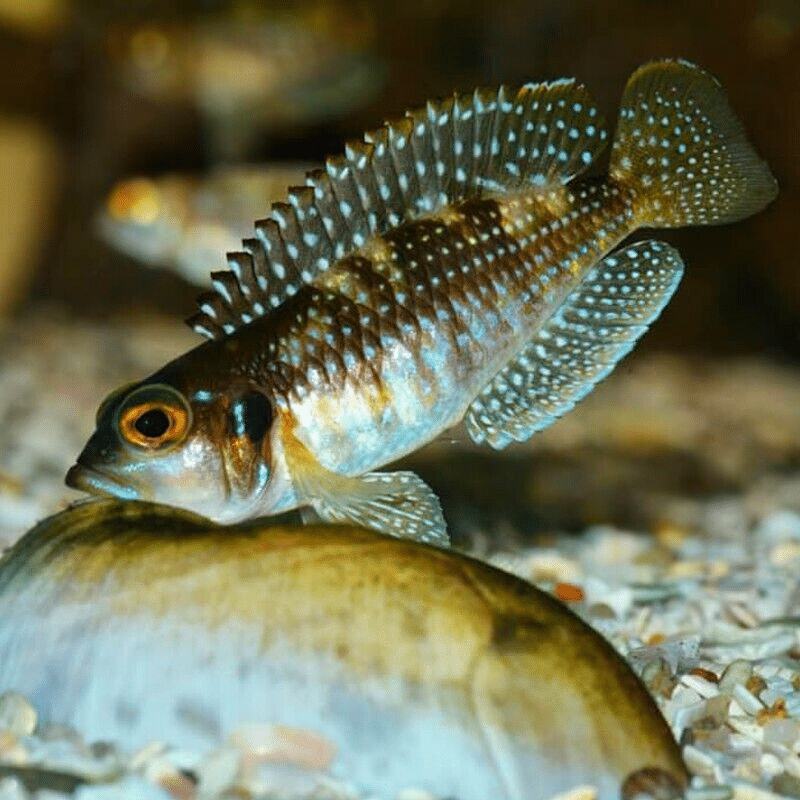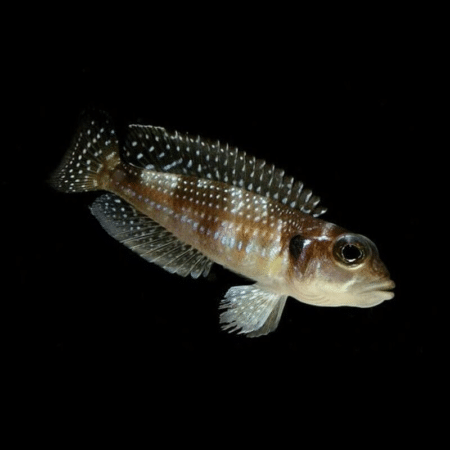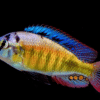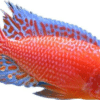Subtotal: £11.61
Meleagris Shell-Dweller – Lamprologus Meleagris – Lake Tanganyika Cichlid, Stunning Shell-Dwelling Fish That Thrives in Freshwater Aquariums with the Right Substrate
£17.49 Original price was: £17.49.£14.52Current price is: £14.52.
Welcome the stunning Meleagris Shell-Dweller, a captivating Lake Tanganyika Cichlid known for its vibrant colors and unique shell-dwelling behavior. This beautiful inhabitant thrives in freshwater aquariums, making it a perfect choice for aquarists seeking elegance and character in their tanks.
995 in stock
Species Introduction
The Meleagris Shell-Dweller, scientifically known as Lamprologus meleagris, is a captivating species of freshwater cichlid native to the stunning waters of Lake Tanganyika in East Africa. This lake is renowned for its rich biodiversity, hosting a plethora of unique aquatic life. The Meleagris Shell-Dweller is particularly notable for its distinct shell-dwelling behavior, which sets it apart from many other cichlid species. These small cichlids exhibit a fascinating combination of vibrant colors and intriguing behaviors, making them a popular choice for aquarists looking to enhance their aquarium with dynamic and visually appealing fish. In their natural habitat, these fish can be found in rocky substrates and sandy areas, often utilizing empty snail shells as both shelter and breeding sites. Understanding their natural environment is crucial for recreating a suitable habitat in your aquarium, ensuring the well-being of these beautiful creatures.
Care Requirements Dashboard
Essential Care Guide for Your Meleagris Shell-Dweller – Lamprologus Meleagris – Lake Tanganyika Cichlid
| Optimal Living Conditions | |
|---|---|
| Water Temperature | 24-26°C (75-79°F) |
| pH Level | 8.1-8.4 |
| Water Hardness | 8-12 dKH |
| Minimum Tank Size | 200L (50 gal) |
| Salinity | 1.020-1.025 SG |
| Care Level | Intermediate |
✓ Care level: Moderate
Tank Size: Minimum 30 gallons
Water Temperature: 75-82°F (24-28°C)
pH Level: 7.8-9.0
Hardness: 10-20 dGH
Providing optimal care for the Meleagris Shell-Dweller involves understanding their specific needs. A minimum tank size of 30 gallons is recommended to accommodate their territorial nature and to provide ample space for swimming and hiding. The water temperature should be maintained between 75-82°F, replicating their natural tropical environment. Additionally, a pH level ranging from 7.8 to 9.0 is ideal, along with a hardness of 10-20 dGH to ensure their health and vitality. Regular water changes and monitoring of these parameters are essential for maintaining a stable environment, as fluctuations can lead to stress and health issues in these delicate fish.
Natural Behavior & Temperament
The Meleagris Shell-Dweller is known for its unique and engaging behavior, which is characterized by its shell-dwelling habits. These fish are naturally territorial and will often claim a specific shell as their home, defending it vigorously against intruders. Their swimming patterns are typically confined to the lower levels of the aquarium, where they feel most secure. In terms of social behavior, they can be quite interactive, especially during breeding season when males display vibrant colors and courtship behaviors to attract females. However, it’s important to note that while they can coexist with other species, they may exhibit aggression towards similar-sized or similarly-shaped fish. Therefore, careful consideration of tank mates is essential to create a harmonious community tank.
Tank Setup Guide
Creating the ideal environment for your Meleagris Shell-Dweller involves replicating their natural habitat as closely as possible. Begin with a sandy substrate, which is essential for their digging behavior and provides a comfortable area for them to explore. Incorporating a variety of shells, such as those from snails or other mollusks, will not only serve as hiding spots but also as breeding sites. Additionally, adding rocks and driftwood can enhance the aesthetic appeal of your aquarium while providing further shelter and territory for these territorial fish. It’s important to ensure that the layout allows for open swimming space while also offering plenty of hiding spots to reduce stress and promote natural behaviors.
Water Quality Management
⚠ Important Water Parameter Notice
pH: 7.8-9.0
Temperature: 75-82°F (24-28°C)
Hardness: 10-20 dGH
Maintaining high water quality is paramount for the health of your Meleagris Shell-Dweller. Regular testing of pH, temperature, and hardness is essential to ensure that these parameters remain stable. A pH level between 7.8 and 9.0 is ideal, as it mimics the alkaline conditions of Lake Tanganyika. The water temperature should be kept within the range of 75-82°F to promote optimal metabolic function. Additionally, hardness levels should be maintained between 10-20 dGH to ensure that the fish can thrive. Implementing a reliable filtration system and performing regular water changes will help maintain these conditions and support the overall health of your aquatic companions.
Feeding & Nutrition
The Meleagris Shell-Dweller is an omnivorous fish, which means that its diet should consist of both plant and animal matter. A balanced diet is crucial for their growth, coloration, and overall health. High-quality cichlid pellets or flakes should form the base of their diet, supplemented with frozen or live foods such as brine shrimp, daphnia, and bloodworms. Additionally, providing blanched vegetables like spinach or zucchini can enhance their diet and promote healthy digestion. Feeding should occur once or twice a day, with only as much food as they can consume in a few minutes to avoid overfeeding and water quality issues. Monitoring their feeding behavior can also provide insight into their health, as a lack of appetite may indicate stress or illness.
Compatibility Guide
When considering tank mates for the Meleagris Shell-Dweller, it is essential to choose compatible species that can coexist peacefully. These fish are generally best kept with other cichlids that are similarly sized and have non-aggressive temperaments. Suitable tank mates may include smaller species of Lake Tanganyika cichlids, such as the Neolamprologus species, which share similar habitat preferences and water conditions. However, it is crucial to avoid larger or more aggressive fish that may intimidate or harm the Meleagris. Territorial disputes can arise, especially during breeding periods, so providing ample hiding spots and territories is vital to reducing aggression and ensuring a peaceful community tank.
Health & Wellness
Maintaining the health and wellness of your Meleagris Shell-Dweller requires regular monitoring and preventive care. Common health issues include ich, fin rot, and swim bladder disease, which can be exacerbated by poor water quality or stress. Signs of illness may include lethargy, loss of appetite, or abnormal swimming patterns. To prevent these issues, ensure that water parameters are stable and that the aquarium is kept clean. Quarantine new fish before introducing them to the main tank to avoid the spread of disease. Regularly observing your fish for any signs of distress or illness will help you address potential problems early, ensuring that your aquatic companions remain healthy and vibrant.
Breeding Information
Breeding the Meleagris Shell-Dweller can be a rewarding experience for aquarists. These fish are mouthbrooders, meaning that the female will carry the fertilized eggs in her mouth until they hatch. To encourage breeding, it is essential to provide a suitable environment that includes plenty of shells for the female to lay her eggs in. The male will display vibrant colors and engage in courtship behaviors to attract the female. Once the eggs are laid, the female will protect them in her mouth, which typically lasts about three weeks. After hatching, the fry can be released into the tank, where they will begin to forage for food. It is important to provide finely crushed food or specialized fry food to support their growth during this critical stage.
Acclimation Process
Acclimating your new Meleagris Shell-Dweller to its new environment is a crucial step in ensuring its health and well-being. Begin by floating the sealed bag containing the fish in the aquarium for about 15-20 minutes to equalize the temperature. After this, gradually introduce small amounts of aquarium water into the bag over the course of an hour. This process helps the fish adjust to the water parameters of the new tank. Once acclimated, gently release the fish into the aquarium, avoiding the introduction of bag water to minimize the risk of introducing contaminants. Monitoring the fish closely for the first few days will help ensure a smooth transition and allow you to address any potential issues promptly.
Long-term Care
The long-term care of your Meleagris Shell-Dweller involves a commitment to maintaining optimal conditions and providing a balanced diet throughout its lifespan. These fish can live for several years when properly cared for, with lifespans typically ranging from 5 to 10 years. Regular water changes, monitoring of water parameters, and a varied diet will contribute to their longevity. As they grow, it is important to reassess tank size and compatibility with other species, as territorial behaviors may change. Creating an environment that mimics their natural habitat will not only enhance their beauty but also promote their overall health and well-being.
Natural Habitat Recreation
Recreating the natural habitat of the Meleagris Shell-Dweller in your aquarium is essential for their comfort and well-being. This involves using a sandy substrate that allows for natural digging behavior, along with an assortment of shells to provide shelter and breeding sites. Incorporating rocks and driftwood can help simulate the rocky shores of Lake Tanganyika, creating a visually appealing and functional environment. Additionally, maintaining stable water parameters that reflect their natural habitat will support their health and vitality. By carefully designing your aquarium with these elements in mind, you can create a thriving ecosystem that mirrors the beauty of their native waters.
Seasonal Care Adjustments
Seasonal changes can impact the care requirements of your Meleagris Shell-Dweller, particularly in terms of temperature and lighting. During warmer months, it may be necessary to monitor the water temperature closely to prevent overheating, while in cooler months, heaters may be required to maintain a stable environment. Adjusting the lighting duration can also play a role in their behavior and breeding cycles, as longer daylight hours may stimulate spawning. Regular observation of your fish during seasonal transitions will help you identify any changes in behavior or health, allowing you to make necessary adjustments to their care routine.
Expert Tips
For those seeking to provide the best care for their Meleagris Shell-Dweller, consider implementing a few expert tips. First, ensure that your aquarium is well-planted with hardy aquatic plants that can thrive in the same water conditions as the cichlids. This not only enhances the aesthetics of the tank but also provides additional hiding spots. Additionally, consider creating multiple territories by placing several shells and rocks throughout the aquarium to reduce aggression among fish. Lastly, maintaining a consistent feeding schedule and monitoring water quality will contribute significantly to the health and happiness of your aquatic companions.
Troubleshooting
Should you encounter any issues with your Meleagris Shell-Dweller, it is important to address them promptly. Common problems include stress from aggressive tank mates, poor water quality, or inadequate hiding spots. If you notice signs of stress, such as hiding excessively or displaying aggressive behavior, consider rearranging the tank layout to provide more territories or reducing the number of tank mates. Additionally, if health issues arise, such as lethargy or loss of appetite, conduct a water test to ensure parameters are within acceptable ranges. By being proactive and observant, you can maintain a healthy environment for your fish friends.
Scientific Background
The Meleagris Shell-Dweller is part of the cichlid family, a diverse group of fish known for their complex behaviors and adaptability. Research into the Lamprologus genus has revealed fascinating insights into their social structures, breeding habits, and ecological roles within Lake Tanganyika. Conservation efforts are crucial for maintaining the biodiversity of this unique ecosystem, as many cichlid species face threats from habitat destruction and overfishing. By understanding the scientific background of the Meleagris Shell-Dweller, aquarists can appreciate the importance of preserving their natural habitats and promoting responsible fishkeeping practices.
Advanced Care Techniques
For experienced aquarists looking to take their care of Meleagris Shell-Dwellers to the next level, consider implementing advanced care techniques. One approach is to establish a breeding colony, which involves maintaining a ratio of one male to several females to encourage natural breeding behaviors. Additionally, utilizing a separate breeding tank can help protect fry from potential aggression in the main tank. Regularly monitoring water parameters and conducting routine maintenance will ensure that the breeding environment remains optimal. Furthermore, exploring the use of natural foods, such as live or frozen options, can enhance the dietary variety and health of your fish friends.
Frequently Asked Questions
Q: What tank size is required for the Meleagris Shell-Dweller?
The Meleagris Shell-Dweller thrives best in a tank of at least 60 litres. This size provides ample space for these cichlids to establish their territories and engage in natural behaviours. A larger tank is always preferable, as it allows for better water quality maintenance and more room for tank mates. Ensure that the aquarium is well-structured with plenty of shells for hiding and breeding, as these fish naturally inhabit shell beds in their native Lake Tanganyika. Providing sufficient space is crucial for their social dynamics and to reduce aggression, which can occur in smaller environments.
✓ Expert Tip
Consider creating a multi-level aquascape with rocks and shells to promote exploration and reduce territorial disputes.
Q: What water parameters do Meleagris Shell-Dwellers require?
Meleagris Shell-Dwellers prefer slightly alkaline water with a pH range of 7.8 to 9.0, mimicking their natural habitat. The water hardness should ideally be between 10 to 20 dGH. Maintaining stable water temperature between 24°C and 28°C is essential to their health. Regular testing for ammonia, nitrites, and nitrates is crucial, as these fish are sensitive to poor water quality. Implementing a reliable filtration system can aid in maintaining these parameters and promoting a healthy environment.
✓ Expert Tip
Consider using a substrate that mimics their natural rocky environment, as this can help buffer the water parameters.
Q: How often should I feed Meleagris Shell-Dwellers?
Feeding Meleagris Shell-Dwellers should be done once or twice daily. A varied diet is crucial for their health; high-quality pellets specifically designed for cichlids, along with occasional treats like frozen or live foods (e.g., brine shrimp), will help maintain their vibrant colours and energy levels. Be cautious not to overfeed, as uneaten food can deteriorate water quality. Monitor their feeding habits and adjust quantities based on their activity levels and growth stage.
✓ Expert Tip
Utilise a feeding ring to prevent food from dispersing too quickly in the tank, ensuring all fish can access their meals.
Q: What are the best tank mates for Meleagris Shell-Dwellers?
When selecting tank mates for Meleagris Shell-Dwellers, consider species that are similarly sized and peaceful, such as other Lake Tanganyika cichlids like Neolamprologus and Julidochromis. Avoid aggressive species that may stress these fish. It is advisable to maintain a ratio of one male to multiple females to reduce aggression and promote a harmonious environment. Additionally, ensure that all fish have ample hiding spots to retreat to, as this will help mitigate territorial disputes.
✓ Expert Tip
Introduce new tank mates gradually to allow established fish to acclimatise to the changes in their environment.
Q: How do I properly acclimatise Meleagris Shell-Dwellers to my aquarium?
Acclimatisation is crucial to ensure the health of your Meleagris Shell-Dwellers. Begin by floating the sealed bag in the aquarium for approximately 15-20 minutes to equalise temperature. After this, gradually introduce small amounts of tank water into the bag every 5-10 minutes for about an hour. This method helps them adjust to the water parameters of your aquarium without causing shock. Once acclimatised, gently release them into the tank, avoiding the introduction of bag water.
✓ Expert Tip
Utilise a drip acclimatisation method for a more gradual adjustment to their new environment.
Q: What are the signs of healthy Meleagris Shell-Dwellers?
Healthy Meleagris Shell-Dwellers exhibit a vibrant colouration, active swimming behaviours, and a strong appetite. They should display natural behaviours such as digging, hiding, and exploring their environment. Conversely, signs of stress or illness may include lethargy, refusal to eat, faded colours, or abnormal swimming patterns. Regular observation and good water quality maintenance are essential in identifying any potential health issues early on.
✓ Expert Tip
Keep a journal of your fish’s behaviour and feeding habits to spot any changes that may indicate health issues.
Q: How do I successfully breed Meleagris Shell-Dwellers?
Breeding Meleagris Shell-Dwellers can be a rewarding endeavour. To encourage breeding, provide plenty of shells for nesting, ensuring they are of various sizes. A slightly higher temperature of around 28°C may stimulate breeding behaviours. Once a pair forms, the female will lay eggs in a shell, and the male will fertilise them. It is essential to maintain excellent water quality during this period, as fry are sensitive to changes in their environment. Separating the breeding pair post-hatching can prevent the male from eating the fry.
✓ Expert Tip
Consider setting up a separate breeding tank to protect the fry and ensure optimal conditions for growth.
Q: What temperature should I maintain for Meleagris Shell-Dwellers?
The ideal temperature range for Meleagris Shell-Dwellers is between 24°C and 28°C. Maintaining a consistent temperature within this range is crucial for their overall health and wellbeing. Sudden fluctuations can lead to stress and susceptibility to disease. Using a reliable aquarium heater and thermometer will help ensure stable conditions. Regular monitoring of the temperature is essential, particularly during seasonal changes, to provide a comfortable environment for your fish.
✓ Expert Tip
Setting up a temperature controller can help automate the heating process and maintain a stable environment.
Q: How long do Meleagris Shell-Dwellers typically live in captivity?
In captivity, Meleagris Shell-Dwellers can live for approximately 5 to 7 years with proper care. Factors influencing their lifespan include water quality, diet, and overall tank conditions. Regular maintenance, including water changes and monitoring for diseases, significantly contributes to their longevity. Providing a stress-free environment with suitable tank mates and hiding spots will also enhance their quality of life and lifespan.
✓ Expert Tip
Document your fish’s health and behaviours to better understand their needs and optimise their care.
Q: What type of substrate is most suitable for Meleagris Shell-Dwellers?
Meleagris Shell-Dwellers prefer substrates that mimic their natural environment, such as fine sand or small gravel. A sandy substrate allows them to dig and create their own hiding spots, which is vital for their wellbeing. Avoid sharp or coarse substrates that may injure their delicate bodies. Layering the substrate with shells will provide additional hiding spots and breeding areas, creating a comfortable habitat for your fish.
✓ Expert Tip
Regularly sift and clean the substrate to prevent waste accumulation and maintain water quality.
Q: What behavioural patterns should I expect from Meleagris Shell-Dwellers?
Meleagris Shell-Dwellers are known for their engaging behaviours. They often form small social groups, displaying territoriality and hierarchy. Expect to see them digging and rearranging substrate, particularly around their shells. Males may exhibit more aggressive behaviours during breeding, while females are often more nurturing. Observing their interactions can provide insight into their social structure and help identify any signs of stress or aggression.
✓ Expert Tip
Provide various hiding spots and visual barriers to reduce stress and encourage natural behaviours.
Q: How can I prevent common diseases in Meleagris Shell-Dwellers?
Preventing diseases in Meleagris Shell-Dwellers begins with maintaining optimal water quality and tank conditions. Regular water changes, routine testing, and proper filtration are essential. Quarantine new fish before introducing them to the main tank to prevent the spread of pathogens. Additionally, ensure a balanced diet to strengthen their immune systems. Observing for early signs of illness, such as changes in behaviour or appearance, can help in addressing issues promptly.
✓ Expert Tip
Consider adding aquarium salt to the water in moderation to help prevent certain diseases, but avoid overuse.
Q: What lighting conditions do Meleagris Shell-Dwellers prefer?
Meleagris Shell-Dwellers thrive in moderate lighting that mimics their natural environment. Too bright lighting may cause stress, while too dim conditions can inhibit their natural behaviours. Using a combination of LED lights with a timer can help create a consistent day/night cycle, promoting their overall health. Incorporating floating plants or decorations can provide shaded areas, allowing the fish to choose their preferred lighting conditions.
✓ Expert Tip
Adjust lighting gradually to prevent shocking the fish and to allow them to acclimatise to changes in their environment.
Q: How do I recognise stress in Meleagris Shell-Dwellers?
Recognising stress in Meleagris Shell-Dwellers involves observing changes in their behaviour. Common signs include hiding more than usual, erratic swimming patterns, refusal to eat, and faded colouration. Additionally, increased aggression towards tank mates may indicate stress. If you notice these behaviours, assess the water quality, tank mates, and environmental conditions to identify possible stressors. Promptly addressing these factors can help return your fish to a state of wellbeing.
✓ Expert Tip
Creating a stable environment with plenty of hiding spots can significantly reduce stress and improve your fish’s quality of life.
Q: What natural habitat conditions should I replicate for Meleagris Shell-Dwellers?
To replicate the natural habitat of Meleagris Shell-Dwellers, focus on creating a sandy substrate with plenty of shells and rocks. The water should be alkaline with a pH of 7.8 to 9.0, and the temperature should be maintained between 24°C and 28°C. Incorporating hiding spots and visual barriers will mimic their native environment, allowing them to express natural behaviours. Maintaining stable water parameters and providing a varied diet will further enhance their wellbeing in captivity.
✓ Expert Tip
Research the specific characteristics of Lake Tanganyika to better understand the needs of your fish friends.



















Anna Campbell (verified owner) –
I recently added the Meleagris Shell-Dweller to my aquarium, and I couldn’t be happier! These small cichlids are not only striking with their unique patterns, but they are also incredibly engaging to watch. After just two weeks in my 20-gallon tank, they have already carved out their own little territories and are displaying such interesting behaviors. I love how they utilize the shells for hiding and nesting—it’s a joy to see their natural instincts in action. Compared to other small cichlids I’ve kept, the Meleagris are more interactive and seem to thrive in a well-planted environment. It’s crucial to maintain good water quality; I recommend doing regular water changes to keep them healthy. The only minor concern is that they can be a bit shy at first, but with patience, they’ll become more outgoing. I would definitely recommend these lovely fish to anyone looking to enhance their aquarium experience, especially those who appreciate the beauty of Lake Tanganyika cichlids. They’ve truly added a spark to my setup!